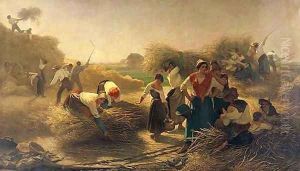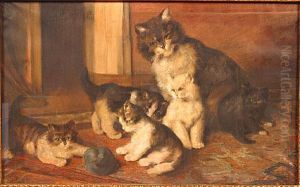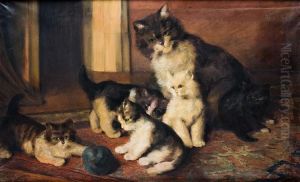Auguste Joseph Herlin Paintings
Auguste Joseph Herlin was a French painter born on October 15, 1828, in Lille, France. He was primarily known for his works in the genre of history painting, which was a popular style during the 19th century that aimed to depict scenes from historical, mythological, and allegorical events with a strong moral or didactic purpose.
Herlin's early life and education remain somewhat obscure, though it is known that he studied painting in Paris. He was a student of François-Édouard Picot, a prominent French painter of the time, known for his neoclassical style and also for teaching other influential artists of the period. Under Picot's guidance, Herlin honed his skills and was exposed to the academic standards of the École des Beaux-Arts, the premier art school in France.
Herlin exhibited his works at the Paris Salon, an official art exhibition of the Académie des Beaux-Arts in Paris, which was the greatest formal venue for artists to showcase their talents in the 19th century. His participation in the Salon demonstrated his recognition and the respectability of his work among his contemporaries. The Salon was a crucial stepping stone for artists seeking to establish their reputation and secure commissions.
During his lifetime, Herlin's work was influenced by the major artistic movements of the time, including Romanticism and later, Realism. Romanticism was characterized by its emphasis on emotion and individualism, as well as glorification of the past and nature. Realism, on the other hand, began in France in the 1850s, and artists in this movement sought to represent subjects truthfully, without artificiality, and avoiding artistic conventions, implausible, exotic, and supernatural elements.
Not much is known about Herlin's personal life or the extent of his artistic career. His death occurred on May 21, 1906, in Saint-Josse-ten-Noode, Belgium. While Herlin may not be as widely recognized as some of his contemporaries, his contributions to the French art world during the 19th century were part of the larger tapestry of evolving artistic styles and the rich cultural milieu of the time.


